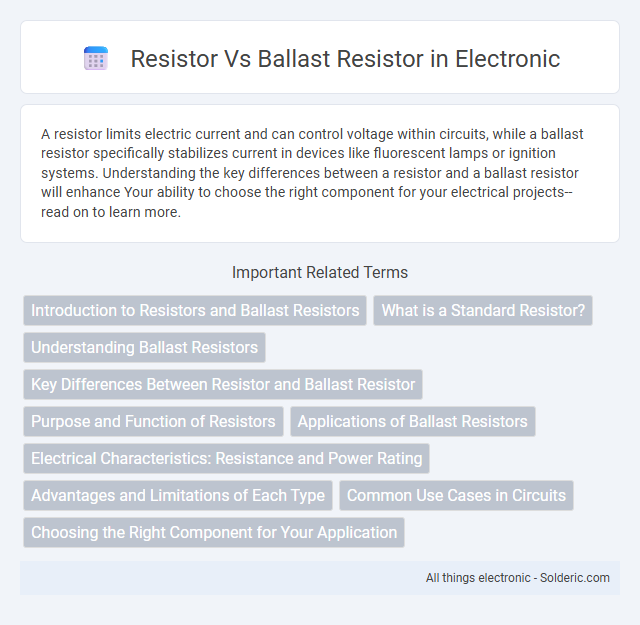A resistor limits electric current and can control voltage within circuits, while a ballast resistor specifically stabilizes current in devices like fluorescent lamps or ignition systems. Understanding the key differences between a resistor and a ballast resistor will enhance Your ability to choose the right component for your electrical projects--read on to learn more.
Comparison Table
| Feature | Resistor | Ballast Resistor |
|---|---|---|
| Function | Limits current, drops voltage in circuits | Regulates current in inductive loads, stabilizes current flow |
| Application | General electronics, current limiting, voltage division | Used in automotive ignition systems, fluorescent lamps, and LEDs |
| Behavior | Constant resistance regardless of current or voltage | Resistance varies with current and temperature (negative resistance) |
| Material | Carbon film, metal film, wire wound | Commonly wire wound for heat dissipation |
| Heat Dissipation | Depends on power rating, can get hot | Designed specifically to handle high heat from current regulation |
| Typical Resistance Range | Ohms to megaohms | Typically low ohms to moderate ohms |
Introduction to Resistors and Ballast Resistors
Resistors regulate electrical current by providing a specific amount of resistance in circuits, ensuring components function within safe limits. A ballast resistor specifically controls current flow in devices like ignition systems or fluorescent lamps, preventing damage from sudden surges. Understanding the difference between standard resistors and ballast resistors helps you design more reliable and efficient electronic systems.
What is a Standard Resistor?
A standard resistor is an electronic component designed to limit or regulate electrical current within a circuit by providing a precise amount of resistance measured in ohms. Unlike a ballast resistor, which is specifically used to control current in devices like fluorescent lamps or ignition systems by dropping voltage to protect components, a standard resistor serves a broad range of purposes across various electronic applications. Its value, tolerance, and power rating are carefully chosen to ensure accurate performance and reliability in controlling current flow and voltage distribution in circuits.
Understanding Ballast Resistors
A ballast resistor is designed to regulate current flow in electrical circuits, preventing damage by limiting excessive current, unlike a standard resistor that primarily controls voltage or divides current. Your understanding of ballast resistors is crucial for applications in automotive ignition systems and fluorescent lighting, where they stabilize current to protect sensitive components. These resistors provide a dynamic resistance that adjusts with temperature, ensuring consistent performance and extending the lifespan of electronic devices.
Key Differences Between Resistor and Ballast Resistor
A resistor is a passive electrical component that limits current flow and divides voltage in a circuit, whereas a ballast resistor specifically regulates current in automotive ignition systems to protect the ignition coil. Unlike general-purpose resistors, ballast resistors are designed to handle higher power dissipation and prevent coil overheating by reducing voltage after startup. The key difference lies in their application: resistors serve broad electrical functions, while ballast resistors ensure stable performance and longevity in ignition circuits.
Purpose and Function of Resistors
Resistors regulate electric current by providing precise resistance to control voltage and current flow in circuits. A ballast resistor specifically limits current to protect components like ignition coils or LEDs from damage due to excessive current. Understanding your circuit's requirements ensures you choose the right resistor type to maintain stability and prevent overheating.
Applications of Ballast Resistors
Ballast resistors are commonly used in automotive ignition systems to regulate current and protect the ignition coil from overheating. They also stabilize current in fluorescent lighting circuits, preventing excessive current flow that could damage the lamp. Your electronic projects benefit from ballast resistors by ensuring consistent performance and extending the lifespan of components.
Electrical Characteristics: Resistance and Power Rating
Resistors typically have a fixed resistance value and power rating designed to limit current and drop voltage in various electronic circuits, with power ratings ranging from a fraction of a watt to several watts depending on application. Ballast resistors specifically manage current flow in automotive and fluorescent lighting systems, often exhibiting higher resistance and power ratings for dissipating excess energy as heat to protect sensitive components. The power rating of ballast resistors is crucial because they must withstand continuous high current and thermal stress without failure, distinguishing them from standard resistors used in low-power circuits.
Advantages and Limitations of Each Type
Resistors provide precise control over current flow and are available in various resistance values with stable performance under a wide range of conditions, making them ideal for applications requiring consistent voltage drops. Ballast resistors specifically limit current in circuits like automotive ignition systems, offering simple and cost-effective protection against current surges but can generate excess heat and reduce overall efficiency. While resistors excel in versatility and precision, ballast resistors are better suited for high-current applications where protective current limiting is crucial despite their thermal limitations.
Common Use Cases in Circuits
Resistors are commonly used in circuits to limit current, divide voltages, and protect components by dissipating excess power. Ballast resistors specifically serve to regulate current in automotive ignition systems and fluorescent lamps, preventing damage caused by sudden surges. Understanding your circuit's requirements helps determine whether a standard resistor or ballast resistor is more appropriate for effective current control.
Choosing the Right Component for Your Application
A resistor is a passive electrical component used to limit current and divide voltage in various circuits, providing precise control of electrical parameters. A ballast resistor, specifically designed for high-current applications like automotive ignition systems or fluorescent lamps, regulates current to prevent damage and ensure stable operation. Choosing the right component for your application depends on understanding the current requirements and the operational environment, where a standard resistor suits low-power circuits and a ballast resistor excels in managing higher power loads.
resistor vs ballast resistor Infographic

 solderic.com
solderic.com